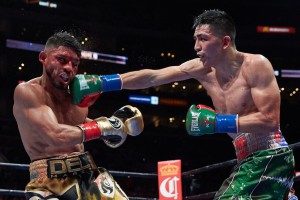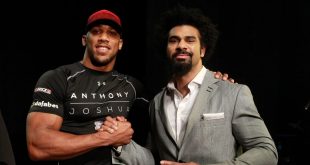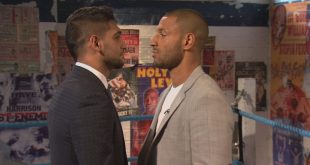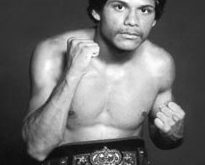By Ivan G. Goldman
Ringside at Staples Center, Los Angeles — I have no idea whether Al Haymon’s complicated PBC business matrix will or will not thrive financially, but if it gives us more fights like Saturday night’s featherweight contest between Abner Mares and Leo Santa Cruz, fans will definitely stick around to see more.

Observers predicting PBC doom are in most cases either ignorant of the budgetary details or they’re business rivals whose gloomy forecasts are grounded more in hope than essential knowledge of cash flow.
What I observed was a boisterous crowd of 13,109 who saw some terrific fights and had a great time. If any of them were shills they must have been top-notch actors because they looked and acted awfully life-like.
The electricity in the arena reminded me of Oscar De La Hoya-Shane Mosley I, a big pay-per-view contest between two other L.A. fighters that was fought in the same building fifteen years ago. But this one was on ESPN, a network that’s part of just about any basic cable subscription, and ticket prices were ratcheted down to a range of $25 to $300, which helps explain the turnout.
This is the kind of card you want to succeed, and it did, at least on a sports and entertainment level. Of course Haymon’s boxing empire also presented that awful Floyd Mayweather-Manny Pacquiao PPV show we saw last May. If life were altogether fair, Mayweather and Pacquiao would have to trade their purses with Santa Cruz and Mares.
But I don’t see it as treasonous to enjoy good cards when they come along, and this one was a barn-burner, with Santa Cruz’s more precisely timed shots winning out over the skill, will, and fortitude of Mares. Every round was an action round. The two scores of 117-111 looked fair. The 114-114 scorecard, which made it a majority decision, was clearly off the mark.
The super bantam co-feature in which sturdy Julio Cesar Ceja stopped the talented Hugo Ruiz was one of those tight contests that could have gone either way until Ceja took over and ended it in round five.
Even the swing bout between up-and-coming lightweight Alejandro Luna and journeyman Sergio Lopez was well worth watching, though one-sided. Lopez, plucked out of a gym in Ensenada on short notice, was representative of lots of Mexican fighters who compete along the border and come north for a quick payday.
Often because they didn’t have time to prepare, they charge out of the corner looking to score a kayo or be kayoed, which is precisely what happened to
Lopez when reality caught up to him in the fourth round and the referee stopped it.
Haymon’s business practices aren’t entirely ethical. A California commissioner told me he’d been caught reserving venues just to deprive rivals promoters of their use. Much has been written about Haymon’s aggressive strategy, clearly aimed at dominating U.S. boxing.
His frequent shows appear on a heavy-hitting squad of channels, including big over-the-air networks that had given up on prizefighting.
One theory about the split between boxing and those big networks is that the fight world was just too unsavory for them. Apparently they prefer athletic competition featuring players who murder people, torture animals, accidentally shoot themselves in nightclubs, slug their fiancées in elevators, and engage in a whole range of other apparently unobjectionable activities.
I don’t completely understand why Haymon calls himself a manager while he puts on shows like a promoter and hires others to handle technical promotional details.
I also don’t understand why someone in his business would refuse to speak to the media. He’s the Howard Hughes of the sports world. But I happened to be seated next to the affable Tim Smith, a former New York Daily News sports columnist who’s now Haymon’s vice president for communications. So what the heck, I asked him if Al was in the building.
“Yes,” Smith answered promptly. When it comes to Haymon, that’s news. At that point Robert Morales of the Los Angeles Newspaper Group turned around and asked Smith for a Haymon interview. No member of the working press, as far as we can determine, has ever been granted one, at least not since he left show business production for boxing.
I promised Morales that I’d put in a good word for him when Al and I go bowling next week. Smith just smiled and took it all in like a man who’s used to such discussions.
But seriously, Smith at one point asked me my opinion on the card and its presentation. I replied it was obviously quite professional and well-organized, but why aren’t there any ring card girls? Seriously.
Ivan G. Goldman’s 5th novel The Debtor Class is a ‘gripping …triumphant read,’ says Publishers Weekly. A future cult classic with ‘howlingly funny dialogue,’ says Booklist. Available now from Permanent Press wherever fine books are sold. Goldman is a New York Times best-selling author.
Photo: Suzanne Teresa, Premier Boxing Champions





